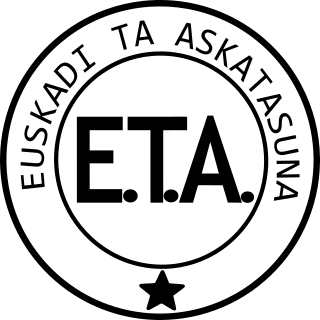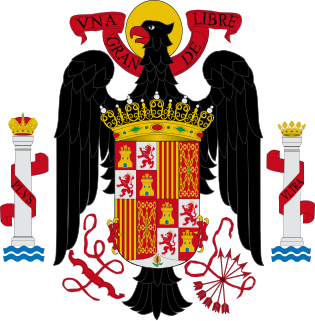Related Research Articles

ETA, an acronym for Euskadi Ta Askatasuna, was an armed Basque nationalist and separatist terrorist organization in the Basque Country. The group was founded in 1959 and later evolved from a group promoting traditional Basque culture to a paramilitary group engaged in a violent campaign of bombing, assassinations, and kidnappings in the Southern Basque Country and throughout Spanish territory. Its goal was gaining independence for the Basque Country. ETA was the main group within the Basque National Liberation Movement and was the most important Basque participant in the Basque conflict.
Fernando Buesa Blanco was a Spanish politician in the Basque Christian Democracy and in the Socialist Party of the Basque Country–Basque Country Left (PSE-EE) branch of the social democratic Spanish Socialist Workers' Party (PSOE). He was assassinated by ETA.

The assassination of Prime Minister Luis Carrero Blanco, also known by its code name Operación Ogro, had far-reaching consequences within the politics of Spain. Admiral Carrero Blanco was killed in Madrid by the Basque separatist group ETA on 20 December 1973. The assassination is considered to have been the biggest attack against the Francoist State since the end of the Spanish Civil War in 1939.
The 2009 Palma Nova bombing occurred on July 30, 2009, when a limpet bomb went off outside a Civil Guard barracks in the town of Palma Nova, Majorca, Spain. The bomb was placed under a patrol car and two Civil Guard officers died as a result of the explosion. A second device was found under another Civil Guard vehicle at nearby barracks and safely exploded by police. On August 9, the Basque nationalist and separatist organisation ETA claimed responsibility for the attack, while four other bombs exploded around restaurants and shopping centres in Palma, Majorca, causing no injuries.

The Basque conflict, also known as the Spain–ETA conflict, was an armed and political conflict from 1959 to 2011 between Spain and the Basque National Liberation Movement, a group of social and political Basque organizations which sought independence from Spain and France. The movement was built around the separatist organization ETA, which had launched a campaign of attacks against Spanish administrations since 1959. ETA had been proscribed as a terrorist organization by the Spanish, British, French and American authorities at different moments. The conflict took place mostly on Spanish soil, although to a smaller degree it was also present in France, which was primarily used as a safe haven by ETA members. It was the longest running violent conflict in modern Western Europe. It has been sometimes referred to as "Europe's longest war".

Santiago Brouard or Santi Brouard was a doctor and Basque politician. He was one of the leaders of Herri Batasuna, and deputy mayor of Bilbao. He was killed by the Spanish government's death squad, the Grupos Antiterroristas de Liberación (GAL), in one of its highest-profile acts. Broaurd was shot by GAL gunmen Luis Morcillo and Rafael López Ocaña as he left his paediatric clinic in Bilbao.

The Zaragoza barracks bombing was a car bomb attack by the Basque separatist organisation ETA, which occurred on 11 December 1987. A vehicle containing 250 kilograms (550 lb) of ammonal was parked beside the main Guardia Civil barracks in the city of Zaragoza, Aragon, Spain; its subsequent explosion killed 11 people, including 5 children. Another 88 people were injured, the majority of them civilians.
The assassination of Juan María de Araluce Villar was a mass shooting attack by the Basque separatist group ETA which took place on 4 October 1976 in San Sebastián in the Basque Country in northern Spain. Three ETA members carrying pistols and submachine guns killed Araluce, the Government appointed President of the Provincial Deputation of Gipuzkoa and member of the Council of the Realm. Araluce's driver was killed in the attack together with three police guards. Ten bystanders were also injured in the attack, which was ETA's deadliest of 1976.
The 1980 Zarautz attack was a mass shooting gun attack by the Basque separatist organisation ETA which occurred on 3 November 1980 in the Basque town of Zarautz in Gipuzkoa. The targets were several off duty civil guards belonging to the traffic department, who were drinking in a bar in the town. The attack was the second deadliest of 1980, the year when ETA killed more people than any other.
The September 1982 Rentería attack was an ambush by the Basque separatist organisation ETA which occurred on 14 September 1982 on the motorway near the Basque town of Errenteria in Guipuzkoa. The targets were several national police officers, four of whom were killed in the attack, with the fifth seriously injured. The attack was ETA's deadliest of 1982.
The 1980 Markina attack was a mass shooting gun attack by the Basque separatist organisation ETA which occurred on 20 September 1980 near the Basque town of Markina. The targets were a group of off-duty civil guards who were having lunch in a bar in the town. Four civil guards were killed. The attack was one of the deadliest of 1980, the year when ETA killed more people than any other.
The Madrid bombings were car bomb attacks carried out by the armed Basque separatist group ETA in Madrid, Spain on 21 June 1993, which killed 7 people and injured a further 29. The target was an army vehicle transporting members of the army. The dead included four Lieutenant colonels, a Commander, a Sergeant and the civilian driver of the vehicle. This was ETA's deadliest attack of 1993.

The Monbar Hotel attack was carried out by the Grupos Antiterroristas de Liberación (GAL), a Spanish state-sponsored death squad, on 25 September 1985 in Bayonne, Pyrénées-Atlantiques, France. The targets were four members of the Basque separatist terrorist group Euskadi Ta Askatasuna (ETA), whom the Spanish government believed to be senior figures in the organization, itself proscribed as a terrorist group in Spain and France. All four people were killed, with a fifth person, apparently unconnected to ETA, injured in the shooting. This represented the deadliest attack carried out by the GAL. Although two of the participants were apprehended shortly after the shooting, controversy surrounded the possible involvement of senior figures in the Spanish police.

The last use of capital punishment in Spain took place on 27 September 1975 when two members of the armed Basque nationalist and separatist group ETA political-military and three members of the Revolutionary Antifascist Patriotic Front (FRAP) were executed by firing squads after having been convicted and sentenced to death by military tribunals for the murder of policemen and civil guards. Spain was Western Europe's only dictatorship at the time and had been unpopular and internationally isolated in the post-war period due to its relations with Nazi Germany in the 1930s and 1940s and the fact that its autocratic leader, Francisco Franco, had come to power by overthrowing a democratically elected government. As a result, the executions resulted in substantial criticism of the Spanish government, both domestically and abroad. Reactions included street protests, attacks on Spanish embassies, international criticism of the Spanish government and diplomatic measures, such as the withdrawal of the ambassadors of fifteen European countries.
The Alianza Apostólica Anticomunista was a Spanish far-right paramilitary organisation active from 1976 to 1983, primarily in the southern Basque Country but also in the French Basque Country and Barcelona. A June 2010 report by the Office for Victims of Terrorism of the Basque Government attributed eight murders with 66 deathly victims to the group and linked it to the National Police Corps, SECED and the Civil Guard. The group attacked the satirical magazine El Papus in Barcelona, killing one person and injuring 17.
On 30 October 2000, the separatist Basque organization ETA detonated a large car bomb on Arturo Soria avenue in Madrid, Spain. The blast killed three people; a Spanish Supreme Court judge, Francisco Querol Lombardero, his driver, and his bodyguard. One of the injured, a bus driver, died from his injuries days later. Sixty-four people were wounded. It was the deadliest attack since the ETA called off its ceasefire in December 1999 and one of numerous attacks in Madrid.

Alberto Jiménez-Becerril Barrio was a Spanish politician of the People's Party (PP) assassinated by the terrorist organization Euskadi Ta Askatasuna (ETA) in 1998.
José Ignacio Ustarán Ramírez was a Spanish politician, candidate for UCD in the first elections for the Basque Parliament and killed by the Basque separatist organization ETA on September 29, 1980.
José Luis Caso Cortines was a Spanish politician, a victim of ETA.
References
- 1 2 "Los presidentes franquistas de la Diputación vizcaína que mató ETA no tendrán placa". El Mundo . 26 October 2010.
- ↑ "Augusto Unceta y sus dos escoltas;Carlos Sanz, Alberto Toca y Juan José Pulido". 8 October 2011.
- 1 2 3 "Opposition joins Señor Suarez in drafting anti-terrorism law as three die in Basque outrage" (PDF). The Times . 9 October 1977.
- ↑ "Basques in pledge to end violent actions" (PDF). The Times . 2 October 1977.
- 1 2 3 Preston, Paul (2003). The Triumph of Democracy in Spain. Routledge. p. 95. ISBN 9781134951413.
- ↑ "Reivindicado por la Triple A". ABC (Sevilla) . 9 October 1977. p. 11.
- 1 2 Clark, Robert (1979). The Basques, the Franco Years and Beyond. University of Nevada Press. pp. 299–300. ISBN 9780874170573.
- 1 2 3 4 5 "Unceta-Barrenechea fue alcalde de Guernica". El País . 9 October 1977.
- 1 2 3 Bruni, Luigi (1994). ETA: historia política de una lucha armada, Volume 2. Txalaparta. p. 45. ISBN 9788486597702.
- 1 2 3 4 5 6 7 8 "Triple asesinato en Guernica". ABC (Sevilla) . 9 October 1977. p. 9.
- ↑ "Official gunned down in Spain". The Herald (Jasper, Indiana). 10 October 1977. p. 3.
- 1 2 3 4 "ETA se atribuye el triple asesinato de Guernica". La Vanguardia . 11 October 1977. p. 17.
- ↑ "Victimas de ETA en El Pais". El País . Retrieved 31 July 2014.
- ↑ "Otro vil atentado". La Vanguardia . 9 October 1977. p. 5.
- ↑ "Unanime Condena". ABC (Sevilla) . 9 October 1977. p. 10.
- 1 2 "Provocaciones de la extrema derecha en el funeral de Guernica". El País . 11 October 1977.
- ↑ "Tension in Spanish armed forces" (PDF). The Times . 10 October 1977.
- ↑ "Socuéllamos tendrá una calle Ángel Rivera, asesinado por ETA en 1977". ABC . 6 August 2008.
- ↑ "Detenido un presunto dirigente de ETA-mílitar". El Periódico de Catalunya . 24 December 1978. p. 6. Archived from the original on 4 March 2016. Retrieved 12 June 2022.
- ↑ "El padre de Aya Zulaica desmiente una nota oficial". El País . 29 December 1978.
- ↑ "El 'etarra' Apaolaza, absuelto del atentado contra Lemóniz y de un asesinato". El País . 30 May 1989.